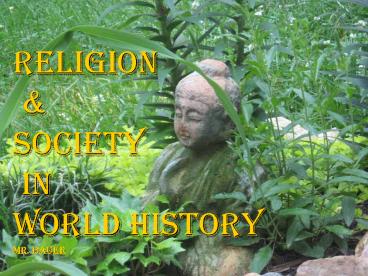Chivalry in Medieval Europe (approx. 500-1300 c .e.) - PowerPoint PPT Presentation
1 / 11
Title:
Chivalry in Medieval Europe (approx. 500-1300 c .e.)
Description:
Religion & society in World History Mr. Bauer – PowerPoint PPT presentation
Number of Views:101
Avg rating:3.0/5.0
Title: Chivalry in Medieval Europe (approx. 500-1300 c .e.)
1
Religion society in World HistoryMr. Bauer
2
Can you Identify these Symbols with a religious
affiliation?
________________?
Buddhism
Confucianism
_______________?
Hinduism
_______________?
Christianity
_______________?
Jainism
_______________?
Sikhism
_______________?
Judaism
_______________?
Shintoism
_______________?
Islam
_______________?
Taoism
_______________?
3
Animistic Beliefs
- Animism is the belief that nature is alive with
spirits that have feelings and can be
communicated with. It is often believed that the
earth itself is alive and has anima (spirit). As
a result almost any animal one can think of has
been worshiped. Mountains, trees, and heavenly
bodies have also been worshiped.
4
Hinduism Religious-Social-Political Implications
- Hinduism teaches of God as being beyond form and
quality. (many interpretations) - -This ultimate reality or divine essence is
referred to as BRAHMAN. - This divine essence 'appears' as the physical
universe and also as all living things
-Therefore all are sacred as they represent an
image of God Ahimsa (nonviolence)
- Hindus greet one another with the phrase,
namaste recognizing this oneness. - The name given to God as our true self is
'Atman'. - Some adherents believe in the dualistic view of
existence where they strive through fulfillment
of dharma within ones caste to attempt to break
the cycle of karma. (Now read your handout on
Dharma and the Caste System) - Adjoining of Atman w/ Brahman
- liberation of karma Moksha(release)
A belief in Reincarnation, Ahimsa, Karma, and
Dharma as a way of life Brahmin priests
having elevated status over Khsatriya rulers /
warriors
5
Ones own dharma, performed imperfectly, is
better than anothers dharma well performed.
Destruction in ones own dharma is better, for to
perform anothers dharma leads to danger. (Bg.
3.35) -Lord Krishna to Arjuna in the
Bhagavad Gita
6
Dharma
7
The Indian-Hindu Caste System
Nobody (No Hindu concept of a Deified Ruler)
Brahmin Priests (Hindu Religion Reigns Above all else!)
Kshatriya Kings, Warriors (Regional Political rulers)
Vaisya Merchants, Farmers, Artisans
Shudra Servants, Tenant Farmers
- This is a rigid religious-
- based hierarchy with
- Social-Political implications
- concerning
- Karma
- Dharma
- reincarnation
Untouchables (unclean laborers)
8
Buddhism !as a reaction to Hinduism
Living in a Hindu Kshatriya Caste family,
Siddhartha (6th century BCE) still felt a need
to discover the truth to life.
- Life is suffering
- Suffering is caused by desire (Tahna)
- To end suffering, end desire
- To end desire, follow the Buddha The Eightfold
Path - Nirvana (release)can be attained through right
actions, intentions, meditation and the
discipline of ones mind. - No creator gods, just the pursuit of
enlightenment - Everything is transient, life is an illusion
- One must discover individual way to Nirvana
- Metta, benevolence, and Dharma, (LAW of
proper behavior through the Buddhas teachings
and actions) - Which groups would find Buddhism so appealing?
Why? Impact in world history?.....
9
Mandate of Heaven Rise and Fall of Political
Dynasties in Chinese History1029 B.C.E. 1912
C.E.
10
Fundamental Principles of ConfucianismThese are
the principles and ethics by which a person
should live by, according to Confucius (5th
century BCE). If a person inculcates these
principles he will be worthy of being called 'the
ideal man' or junzi.Jen The most important
of all principles. It means being kind and humane
to your fellow beings. It is about helping out
others - benevolence.Li The principle of
self-restraint and sense of propriety that should
be inculcated in a person humility. A person
should always act in a honorable way and respect
his elders, his ancestors and his family members
(Filial Piety). It includes following of all the
social etiquettes and mannerisms rites. Hsiao
Hsiao is love for the immediate family and then
society. It's the principle of love of parents
for their children and of children for their
parents. If every family is united and happy, the
society will prosper.Yi The principle of
righteousness. It is upholding what is right
above everything else and sacrificing oneself for
it, if need be.Shu reciprocity doing onto
others.Chung Loyalty to one's family and to
one's country. Loyalty is a quality which binds a
country strongly together.The Five
RelationshipsConfucius specified the five
important relationships that an individual is a
part of. If he maintained each of those
relationships dutifully, the society will
stabilize and prosper automatically. Ruler to
subject Father to son Husband to wife Older
brother to younger brother Friend to friend
11
Confucian Philosophy and the Greater Society
Mandarins
Not so much a religion, as a Socio-political
system of principles and ethics!
Mean People
- Question Where is the Emperor in society?
- With the exception of the top, this pyramid does
not necessarily reflect hierarchy, and is
sometimes re-arranged by various scholars. - Scholars are highly revered in a Confucianist
society due to the admiration for EDUCATION and
the learned Gentleman (merited status). The
aristocracy were born into their status. - Farmers by NO MEANS were more influential then
the merchant class. They simply epitomize the
Confucianist qualities of humility and obligation
towards the welfare of the state, rather then
seeking profit as merchants do.

